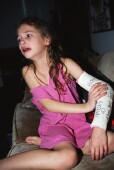
MONDAY, July 19 (HealthDay News) — Outdoor summer fun can sometimes lead to falls and injuries in children, so parents would be wise to get informed about the use of medical imaging tests before an emergency occurs that requires X-rays or CT scans, an expert says.
Recent media reports about high levels of ionizing radiation associated with frequent use of CT scans may cause parents to be concerned about the safety of radiology and imaging tests in children, noted Dr. Helene Pavlov, radiologist-in-chief at the Hospital for Special Surgery in New York City, in a news release from the hospital.
Because children are still growing, their bodies are more susceptible than adults to the effects of ionizing radiation, so it’s important to limit children’s exposure, Pavlov explained. Parents should ask if their hospital emphasizes ALARA, the acronym for “as low as reasonably achievable” with regard to ionizing radiation, she suggested.
Before agreeing to an imaging examination for a child, Pavlov advises parents to keep the following points in mind:
- Ask what the doctor believes is the problem and whether it’s possible to use a non-ionizing radiation imaging method such as MRI or ultrasound for diagnosis.
- Ensure that the radiation technologist shields the child and confines the areas being exposed to ionizing radiation.
- Ask if the technique being used has been adjusted to the size of the child.
- Ask about “repeat rates” — that is, how often an image needs to be repeated because of excessive motion, incorrect positioning or improper technique. If a hospital’s repeat rate is high, parents may want to consider a different imaging center for their child’s examination, Pavlov suggested.
- It’s also a good idea for parents to ask how many children undergo medical imaging tests at a facility. The higher the percentage of children, the more experience the imaging team has in achieving a correct image on the first attempt.
More information
The American College of Radiology, Radiological Society of North America has more about children and CT scans.

